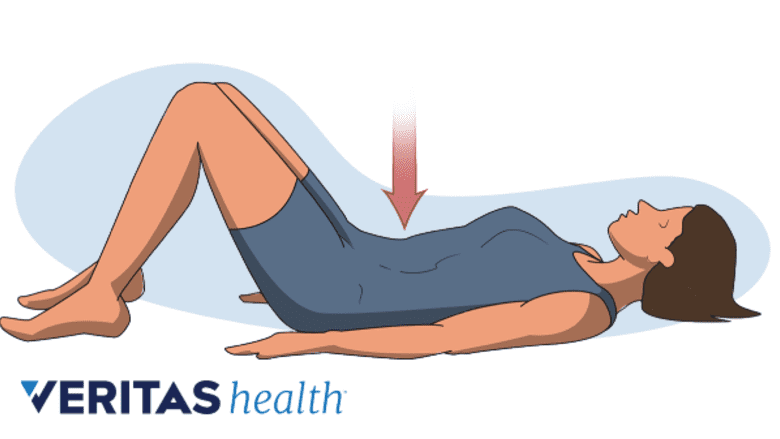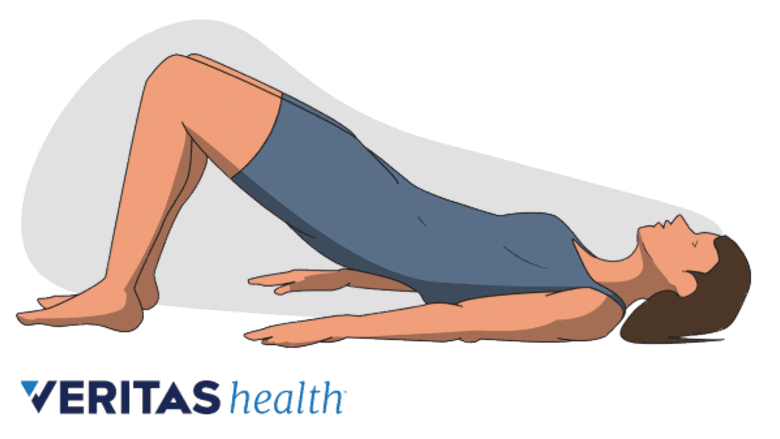Physical therapy for lower back pain comprises a combination of strengthening, stretching, and core-building exercises that aim to:
- Activate and train the muscles surrounding the spine to provide better support and stability to the lower back
- Foster healing in the spinal tissues to reduce pain, improve balance, and restore mobility
The exercise regimen typically starts with fewer repetitions and sets, working up to more repetitions as strength begins to build in the lower back.
The exercises described below are specifically designed to treat lower back pain by building endurance in the lumbar, pelvic, and leg muscles over a period of time.
In This Article:
Pelvic Tilt

A pelvic tilt is a strengthening exercise where the abdominal muscles are used to move the spine.
- Lie on the floor with knees bent and feet flat on the floor.
- Tighten the lower abdominal muscles, pulling the navel and lower back toward the floor, without using buttocks or leg muscles.
- Hold for 10 seconds and release.
Aim to do 3 sets of 10 repetitions.
Wall Hamstring Stretch

A hamstring stretch keeps the hamstring muscles in the thigh elongated and flexible, which can help stabilize and support the spine.
- Lie on the back near a wall or doorjamb.
- With one leg stretched out on the floor, rest the other leg against the wall without bending the knee.
- Hold this stretch for 30 seconds to a minute.
Aim to perform 2 sets of 3 repetitions on each leg.
Kneeling Lunge Stretch

The kneeling lunge stretch improves flexibility and mobility in the hip flexor muscles located in the front top part of the thigh.
- Start in a kneeling position and then place one foot flat on the floor.
- Place both hands on the thigh with the weight of the body evenly distributed between both legs.
- Shift the hips forward until a gentle stretch is felt through the front of the hip.
- Hold the stretch for up to 30 seconds on each side.
Aim to perform 2 sets of 3 repetitions on each leg.
Standing lunge stretch
If kneeling is difficult, this exercise can be modified by standing with one foot in front of the other, placing both hands on the hips or a wall for balance, and shifting the weight forward—until a gentle stretch is felt through the front of the hip. Hold and repeat as in the kneeling variation.
Bird Dog

The bird-dog exercise helps activate the spinal and core muscles to improve core strength and spinal stability.
- Start in a 4-point position.
- Extend one leg to the back, keeping the knee as straight as possible.
- Simultaneously, raise the opposite arm parallel to the floor. Do not arch in the back or neck, or let the pelvis rotate.
- Hold this position for 4 to 6 seconds and slowly lower back to the starting position.
Aim to complete 2 sets of 4 to 6 repetitions of this exercise.
Bridge

Similar to bird dog, a bridge exercise helps improve core strength and spinal stability.
- Lie on the back and bend both knees with arms tucked to the side.
- Slowly raise the buttocks off the floor.
- Aim to align the back in a straight line from the shoulder to the pelvis.
- Hold the bridge for 8 to 10 seconds and slowly lower back to the starting position.
Aim to complete 2 sets of 10 bridges.
If pain or discomfort is felt at any point while performing these exercises, it is recommended to stop and seek medical attention. It is helpful to learn these exercises from a trained medical professional to follow the correct posture and tailor the intensity or technique to suit individual needs and limitations.
Editor’s Top Picks

